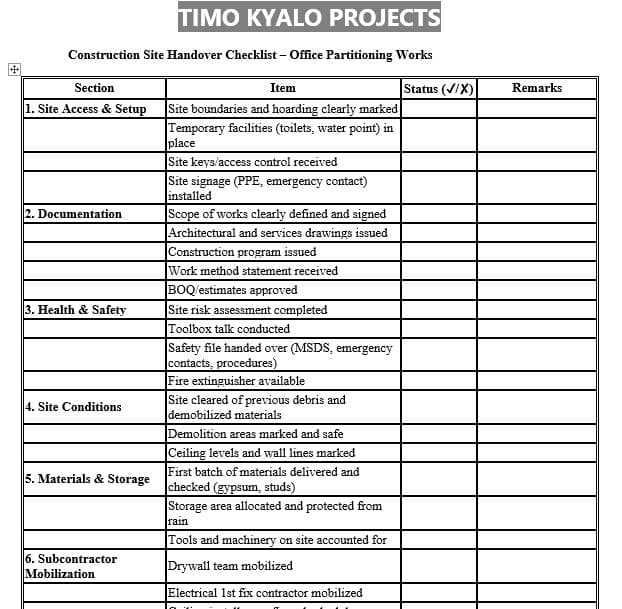
Table of Contents
Open Table of Contents
Introduction
Site supervision is the heartbeat of any construction project — especially in interior fit-out works where timelines are tight and trade coordination is critical.
A well-organized supervisor ensures the day starts with clarity, runs with order, and ends with progress. In this post, I break down the key duties, structure, and thinking behind daily site supervision — based on my real experience managing fit-out projects, including corporate interiors like NCBA Tatu City.
Key Responsibilities of a Site Supervisor
The role of a site supervisor is not about shouting instructions — it’s about enabling smooth execution, preventing delays, and holding the team accountable. Core responsibilities include:
- Daily Briefings: Aligning teams with daily targets and safety updates
- Workforce Oversight: Tracking attendance, deployment, and performance
- HSE Compliance: Enforcing PPE, fire safety, and clean workspaces
- Quality Control: Ensuring workmanship meets specs and manufacturer standards
- Communication: Reporting progress and blockers to the PM or client team
The best supervisors are early to site, observant of detail, and decisive in problem-solving.
Daily Routine and Site Flow
Consistency breeds control. Here’s a simplified daily flow that I follow:
⏰ Morning Setup
- Confirm team attendance and assign daily targets
- Inspect material deliveries and tool readiness
- Conduct toolbox talks and safety reminders
🏗️ Mid-Morning Coordination
- Verify that work aligns with shop drawings
- Walk the site to identify delays, defects, or safety hazards
- Resolve technical questions with trades before they escalate
📝 Afternoon Checks
- Inspect ongoing and completed work
- Take progress photos and update daily site log
- Cross-check deliveries against planned usage
- Ensure cleanup and secure storage of tools/materials
Tip: A printed checklist on a clipboard improves consistency and simplifies delegation when you step away.
Managing Subcontractors and Resources
In a typical fit-out project, multiple subcontractors (drywall, ceiling, paint, MEP, carpentry) operate simultaneously.
My Coordination Approach:
- Scope Handovers: Review expectations and access requirements before works begin
- Short-Term Targets: Break down weekly goals into daily measurable outputs
- Conflict Prevention: Sequence works to avoid trade clashes — e.g., ducting before ceiling grid
- Material Buffering: Maintain buffer stock of fast-moving items like gypsum, screws, or adhesive
Supervisors who plan ahead reduce downtime and prevent blame games on site.
Monitoring Quality and Progress
Time and quality are always under pressure — especially in interior fit-out where client expectations are high.
Here’s how I maintain standards:
- Daily Walkthroughs: Early detection of poor finishes or misalignments
- Marked-Up Drawings: On-site sketches and redlines for installers
- Client Walks: Schedule inspections before key closures (e.g. ceiling, MEP cover-ups)
- Snag Logging: Note and track items needing rework with photos and deadlines
Projects like NCBA Tatu City proved that strong supervision can deliver clean finishes without delays — even under pressure.
Conclusion
Fit-out site supervision is part coordination, part anticipation, and part accountability. A disciplined supervisor prevents small issues from becoming major delays.
Whether you’re supervising an office, bank, or retail fit-out — your habits, structure, and checklists are what drive execution.
📥 Free Resource
Want to start your day like a pro?
👉 Download My Site Supervision Daily Checklist (Excel/PDF)
Print it. Use it. Improve it.